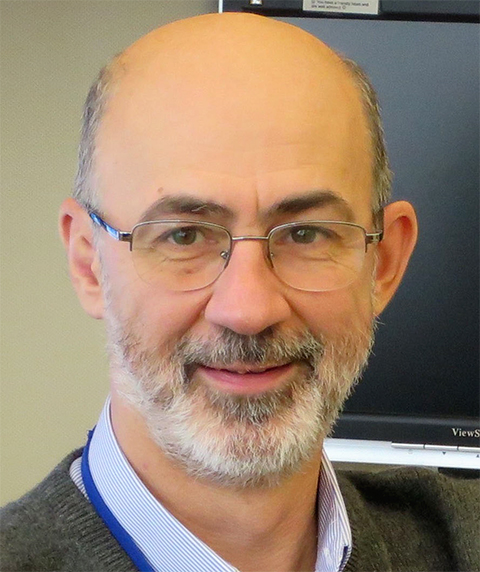
Balla leaves no phosphoinositide unturned
An exquisite experimentalist, a creative thinker, a humble and honest man. This is how colleagues describe Tamas Balla, the 2024 recipient of the American Society for Biochemistry and Molecular Biology’s Avanti Award in Lipids.
But the lipid world almost lost Balla to radiology. “During medical school in Hungary, I was attracted to physics and emerging imaging technologies,”he said. In the early 1980s, with computerized tomography and magnetic resonance imaging rapidly evolving, the radiology field had plenty of both. Professor Andras Spat, a physiologist, got Balla interested in laboratory research. “I would not be a scientist if it wasn’t for him,” Balla said. “He recruited me to his lab as a medical student and infected me with the research bug. He was an exceptional mentor who encouraged me to think about organ systems and molecular mechanisms.”

Years later, Balla satisfied his fascination for technology and images at a microscopic scale. As head of the Section on Molecular Signal Transduction at the Eunice Kennedy Shriver National Institute of Child Health and Human Development, he has focused on the intricacies of phosphoinositide-mediated lipid signaling. Balla has purified, cloned and characterized key pathway enzymes, developed biosensors to visualize and track these lipids and repurposed molecular biology techniques to alter phosphoinositide levels artificially.
Julie Brill, Pietro De Camilli and Anirban Banerjee nominated Balla for the Avanti Award, noting his outstanding collegiality. “His generous sharing of these tools has pushed the field forward dramatically by enabling rapid progress on many fronts,”they wrote.
Volker Haucke, winner of the 2017 Avanti Award in Lipids, wrote in support of the nomination, “Tamas Balla has pioneered the visualization and manipulation of signaling lipids in live cells, thereby enabling the transition of the entire field from the biochemical era of the 20th century to modern cell and molecular biology.”
Small lipids, big responsibilities.
Phosphoinositides are phospholipids present in eukaryotic membranes. When targeted by kinases and phosphatases, they produce essential signaling molecules. Although not abundant compared to other lipids, phosphoinositides and their derivatives play important roles in membrane dynamics during endo- and exocytosis, signal transduction from surface receptors, immune response and brain development and function.
Tamas Balla has studied phosphoinositide-based signaling from top to bottom. “He began studying inositol trisphosphate signaling downstream of angiotensin II receptors but quickly became interested in upstream metabolic steps in the pathway,” nominators Brill, De Camilli and Banerjee wrote.
Discussing the impact of Balla’s research, Haucke wrote,“(H)is groundbreaking studies on lipid kinases and phosphatases have paved the way for the development of vast biomedical applications.”
Nevertheless, Balla cautions against forcing translational science at the expense of basic science in response to external pressure.
“While my focus was on enzymes, year after year, we made discoveries important to other fields like vesicular trafficking, Golgi function, viral replication, and neurodegenerative diseases,” he said. “All this came to us without consciously trying to be translational. The practical application of your discoveries can be unpredictable. But if you follow your passion and do high-quality research, it will eventually come to you.”
Balla’s latest research focuses on the nuances of lipid compartmentalization within the cell. He recently reported a mechanism by which phosphoinositides and lipid transfer proteins cooperate to mediate nonvesicular lipid transfer between the plasma membrane and the endoplasmic reticulum.
2024 ASBMB award winners
Phillips turns parasite’s metabolic weakness into hope for human health
Herbert Tabor Research Award: Margaret Phillips
Ando's pioneering journey: From physics to structural enzymology
Mildred Cohn Young Investigator Award: Nozomi Ando
Stoddard changes mentoring practices in academia
Ruth Kirschstein Diversity in Science Award: Shana Stoddard
For Wolfson, every classroom is a laboratory
ASBMB Sustained Leadership Award: Adele Wolfson
Kennelly considers his fortune of three careers
William C. Rose Award for Exemplary Contributions to Education: Peter Kennelly
From virology to immunology, Wu focuses on structure
Bert & Natalie Vallee Award in Biomedical Science: Hao Wu
Stillman charts the path of genome replication
Earl And Thressa Stadtman Distinguished Scientist Award: Bruce Stillman
In failure, Simcox finds a way to learn
Walter A. Shaw Young Investigator in Lipid Research Award: Judith Simcox
Roos’ career pivot to maximize impact
Alice and C.C. Wang Award in Molecular Parasitology: David S. Roos
Enjoy reading ASBMB Today?
Become a member to receive the print edition four times a year and the digital edition monthly.
Learn moreGet the latest from ASBMB Today
Enter your email address, and we’ll send you a weekly email with recent articles, interviews and more.
Latest in People
People highlights or most popular articles

Mydy named Purdue assistant professor
Her lab will focus on protein structure and function, enzyme mechanisms and plant natural product biosynthesis, working to characterize and engineer plant natural products for therapeutic and agricultural applications.

In memoriam: Michael J. Chamberlin
He discovered RNA polymerase and was an ASBMB member for nearly 60 years.

Building the blueprint to block HIV
Wesley Sundquist will present his work on the HIV capsid and revolutionary drug, Lenacapavir, at the ASBMB Annual Meeting, March 7–10, in Maryland.

In memoriam: Alan G. Goodridge
He made pioneering discoveries on lipid metabolism and was an ASBMB member since 1971.

Alrubaye wins research and teaching awards
He was honored at the NACTA 2025 conference for the Educator Award and at the U of A State and National Awards reception for the Faculty Gold Medal.

Designing life’s building blocks with AI
Tanja Kortemme, a professor at the University of California, San Francisco, will discuss her research using computational biology to engineer proteins at the 2026 ASBMB Annual Meeting.

